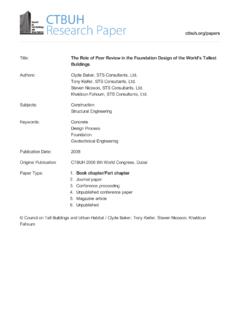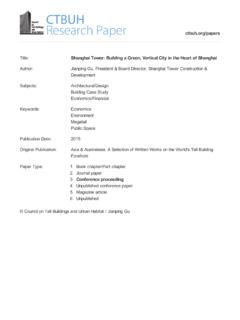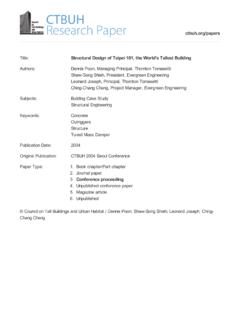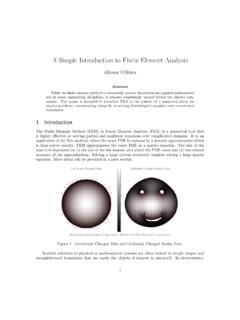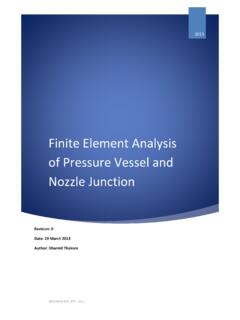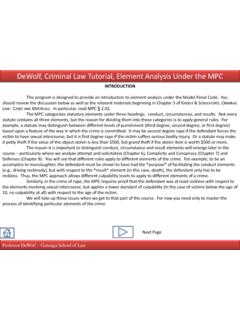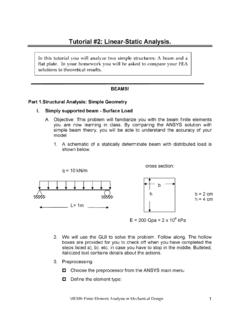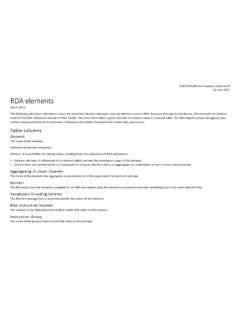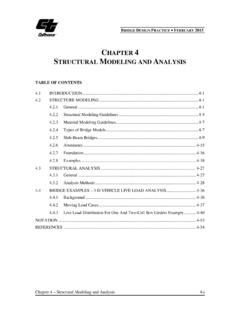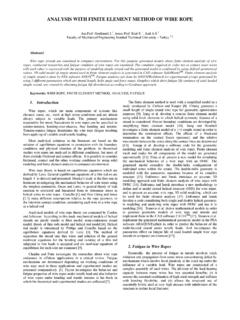Transcription of International Journal of High-Rise Buildings
1 Title:Detailed Finite Element analysis of Full-scale Four-story Steel FrameStructureAuthors:Hiroyuki Tagawa, National Research Institute for Earth Science and DisasterPreventionTomoshi Miyamura, National Research Institute for Earth Science and DisasterPreventionTakuzo Yamashita, National Research Institute for Earth Science and DisasterPreventionMasayuki Kohiyama, Keio UniversityMakoto Ohsaki, Hiroshima UniversitySubject:SeismicKeywords:Seismi cSteelVibrationsPublication Date:2015 Original Publication: International Journal of High-Rise Buildings 2015 Number 1 Paper Type:1. Book chapter/Part chapter2. Journal paper3. Conference proceeding4. Unpublished conference paper5. Magazine article6. Unpublished Council on Tall Buildings and Urban Habitat / Hiroyuki Tagawa; Tomoshi Miyamura; Takuzo Yamashita;Masayuki Kohiyama.
2 Makoto Journal of High-Rise BuildingsMarch 2015, Vol 4, No 1, 65-73 International Journal ofHigh-Rise Finite Element analysis of Full-scale Four-story Steel Frame Structure subjected to Consecutive Ground MotionsHiroyuki Tagawa1,2, , Tomoshi Miyamura1,3, Takuzo Yamashita1,Masayuki Kohiyama4, and Makoto Ohsaki51 Hyogo Earthquake Engineering Research Center, National Research Institute for Earth Science and Disaster Prevention,Miki 673-0515, Japan2 Department of Architecture, Mukogawa Women s University, Nishinomiya 663-8121, Japan3 Department of Computer Science, College and Engineering, Nihon University, Koriyama 963-8642, Japan4 Department of System Design Engineering, Faculty of Science and Technology, Keio University, Yokohama 223-8522, Japan5 Department of Architecture, Graduate School of Engineering, Hiroshima University, Higashi-Hiroshima 739-8627, JapanAbstractDetailed finite element (FE) analyses of a full-scale four-story steel frame structure, subjected to consecutive 60% and 100%excitations from the JR Takatori records during the 1995 Hyogoken-Nanbu earthquake, are conducted using E-Simulator.
3 Thefour-story frame was tested at the largest shake-table facility in the world, E-Defense, in 2007. E-Simulator is a parallel FEanalysis software package developed to accurately simulate structural behavior up to collapse by using a fine mesh of solidelements. To reduce computational time in consecutive dynamic time history analyses, static analysis with gravity force isintroduced to terminate the vibration of the structure during the analysis of 60% excitation. An overall sway mechanism whensubjected to 60% excitation and a story mechanism resulting from local buckling of the first-story columns when subjected to100% excitation are simulated by using E-Simulator. The story drift response to the consecutive 60% and 100% excitations isslightly smaller than that for the single 100% :Finite element analysis , Seismic response, Collapse, Consecutive excitation, E-simulator1.
4 IntroductionThe world s largest three-dimensional (3D) shake-tabletest facility, E-Defense, was constructed at the HyogoEarthquake Engineering Research Center of the NationalResearch Institute for Earth Science and DisasterPrevention (NIED), Japan, in 2005 (Ohtani et al., 2004;Hyogo Earthquake Engineering Research Center, 2015).A full-scale four-story steel frame structure, which is theobject of simulation in this study, was tested at E-Defensein 2007 (Yamada et al., 2008; Suita et al., 2008). Simul-taneously, at NIED, a parallel finite element (FE) analysissoftware package, E-Simulator, was developed to accura-tely simulate the seismic behavior of building, bridge, andunderground structures up to collapse (Hori et al., 2007).The platform of E-Simulator is a general purpose parallelFE analysis code, ADVENTUREC luster (Allied Engi-neering Corporation, 2015), and E-Simulator allows large-scale parallel computation for simultaneous simulation ofboth global and local behavior, including buckling andfracture, by using a fine mesh of solid elements .
5 DynamicFE analyses of the four-story steel frame structure usinga very fine mesh of solid elements were conducted byusing E-Simulator (Miyamura et al., 2011; Miyamura etal., 2015). In these analyses, local buckling behavior at thetop and bottom ends of the first-story columns and storymechanism were successfully simulated for a single exci-tation. However, the influence of the consecutive strongground motions used for the E-Defense shake-table testwas not researchers have investigated residual stresseffects on the seismic performance of structures (Lu et al.,2001; Okazaki et al., 2009; Mathur et al., 2011). Lu andMacRae (2011) conducted pushover and push-pull ana-lyses and incremental dynamic analyses on a single canti-lever column with nonlinear beam-column fiber sectionsunder moderate compressive axial load.
6 The resultsshowed that whereas the initial residual stresses do havesome effect on structural behavior at the first yielding, thepostyielding behavior is not affected. Okazaki et al.(2009) conducted monotonic pushover and cyclic push-pull analyses on steel frame structures modeled by fiberelements to compare the structural responses with andwithout the initial residual stresses and initial imperfec-tions. They concluded that the initial residual stresses andimperfections accelerate frame collapse for cases in which Corresponding author: Hiroyuki TagawaTel: +81-798-67-4519; Fax: +81-798-67-4501E-mail: Tagawa et al. | International Journal of High-Rise Buildingsdeformation is concentrated in a small number of , several researchers have investigated theeffects of accumulated damage induced by multiple strongground motions (Takeda et al.)
7 , 2011; Mizushima et al.,2014). Mizushima et al. (2014) conducted detailed FEanalyses on a three-story steel frame, which was tested atE-Defense in 2014 (Namba et al., 2014), for single andconsecutive ground motions. The steel frame was modeledby shell elements and the concrete slab was modeled bysolid elements . An analysis found that the drift responsefor consecutive excitations was smaller than that forsingle excitation. They stated that one possible reason forthis result is strain this study, dynamic FE analyses are conducted byusing E-Simulator for consecutive 60% and 100% excita-tions of the JR Takatori records of the 1995 Hyogoken-Nanbu earthquake. Simulation results are compared withthose for the single 100% excitation to evaluate the effectsof consecutive excitations on structural Finite Element ModelingThe specimen was a four-story, two-bay by one-baysteel moment-resisting frame structure, as shown in Each story is m high, making the overall specimenheight equal to approximately 14 m.
8 This is a typical steelbuilding designed and constructed according to the currentdesign specifications and practice in Japan (Yamada etal., 2008; Suita et al., 2008). The columns are made ofcold-formed square-tube, beams are made of hot-rolledwide-flange, and through diaphragm connection details areadopted, in which short brackets are shop-welded to thecolumns. Table 1 provides a list of member FE model for the four-story steel frame structure,which primarily consists of hexahedral solid elements , asshown in Fig. 2, has 4,543,243 elements , 6,330,752 nodes,and 18,992,256 degrees of freedom. This analysis utilizesa hexahedral element using linear functions enhanced byincompatible modes (Simo and Rifai, 1990; Simo andArmero, 1992).
9 The element is fully integrated using eightintegration points. The modeling details are described inprevious studies (Miyamura et al., 2011; Miyamura et al.,2015). The FE models of column, beam, deck plate, andwire mesh are shown in Fig. 3. The results of compositebeam tests conducted by Yamada et al. (2009) indicatedthat the contact of a column to a slab influences the res-ponse of the beam during cyclic loading. However, be-cause it is computationally expensive to simulate dyna-mic contact in the current version of E-Simulator basedon ADVENTUREC luster, no contact condition is consi-dered in this study. Accordingly, the two surfaces of thecolumn and slab are always separated and not in Material Properties, Constitutive Model, and Natural PeriodsThe self-weight of the steel is computed based on a massdensity of 103 kg/m3.
10 The mass density of 103 Figure 1. Framing and elevation of four-story steel frame 1. List of member sectionsBeamColumnFloorG1G11G12 StoryC1, C2RH-346 174 6 9H-346 174 6 9H-346 174 6 94 SHS-300 300 94H-350 175 7 11H-350 175 7 11H-340 175 9 143 SHS-300 300 93H-396 199 7 11H-400 200 8 13H-400 200 8 132 SHS-300 300 92H-400 200 8 13H-400 200 8 13H-390 200 10 161 SHS-300 300 9 Detailed Finite Element analysis of Full-scale Four-story Steel Frame Structure subjected to Consecutive Ground Motions67 Figure 2. FE model for four-story steel moment-resisting frame 3. FE models of column, beam, deck plate and wire 2. Material propertiesMemberSteelSectionElementMeasu red properties (N/mm2)Yield strengthTensile strengthBeamSN400BH-340 175 9 14flange309443web355468H-346 174 6 9flange333461web382483H-350 175 7 11flange302441web357466H-390 200 10 16flange297451web317458H-396 199 7 11flange311460web369486H-400 200 8 13flange326454web373482 ColumnBCR295 SHS-300 300 9first story330426second-fourth story33241968 Hiroyuki Tagawa et al.

